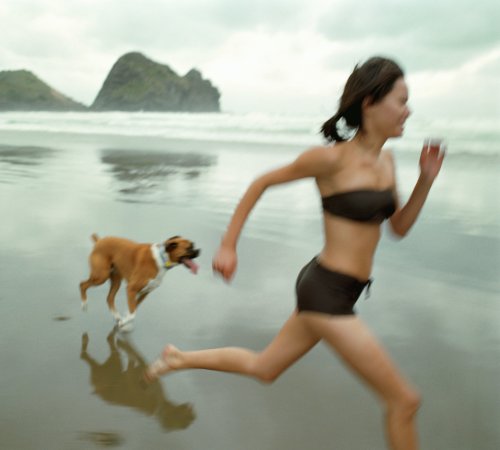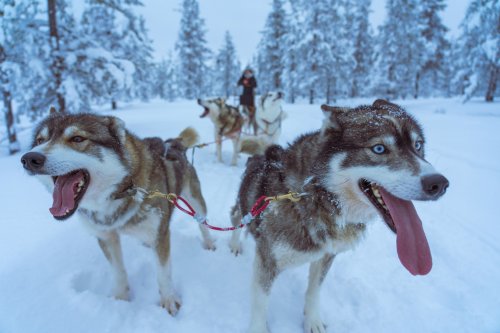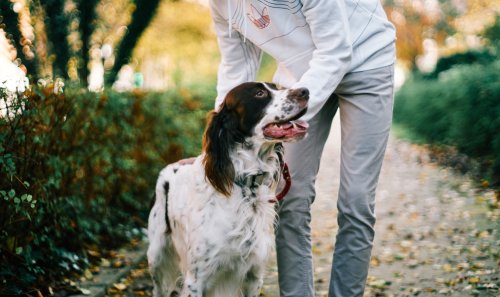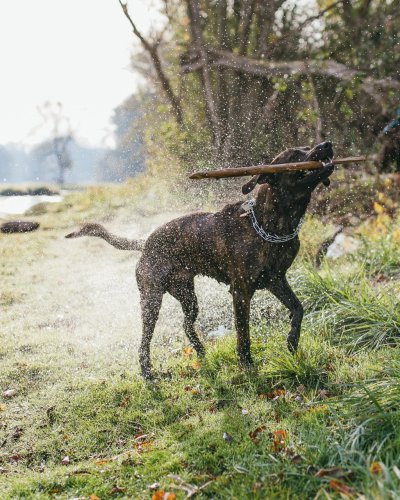Setting up for Canine Fitness Training: A Quick Guide
Dog lovers and owners strive for their companion animals or canine athletes to live as long and happily as possible. The formula for healthy dogs, among other things, includes maintaining their physical fitness. Exercising your dog can be fun for you and them, but there are a few things to consider when conducting fitness training.
The Elements of Canine Fitness

Regular fitness is indispensable when it comes to the health of our pets. Canine conditioning through specific exercises aims for the healthy development of dogs and the improvement or maintenance of their general fitness level. It works on muscle mass, strength, coordination, and balance while always keeping injury prevention in mind.
Canine physical fitness is often understood vaguely, and it's usually associated with well-known activities such as running or even mere walking on a leash. But if we look for a definition in human literature, we discover that this topic is more complex. For example, the American College for Sports Medicine explains physical fitness as measurable health and skill-related (athletic ability) attributes. Health-related components include cardiorespiratory endurance, muscular endurance and strength, body composition and mobility. According to this definition, skill-related components are agility, balance, coordination, speed, power, and reaction time.
Benefits of Canine Conditioning

The benefits of regular and varied exercises are often visible externally but also have numerous internal benefits too. On a physical level, exercise results in improved body awareness, balance, flexibility, and muscle strength. A dog that exercises regularly and builds muscles to support its joints is less likely to get injured during physical activities than a dog whose fitness training consists of less stimulating exercises.
Canine conditioning exercises focus on all the muscles in a dog's body, which is not the case with common activities such as running or walking. During these daily activities, the focus is on the large muscle groups, while the smaller muscles that support the joints and protect against injuries are neglected. Without targeted exercises, this can lead to muscle imbalances in the dog's body and potential health problems.
One of the main benefits of canine fitness is maintaining a healthy weight, especially if we keep in mind that, according to the Association for Pet Obesity Prevention, in 2018, 56% of dogs in the USA were obese.
The benefits, of course, go beyond physical welfare. Exercises in dogs cause mental stimulation, improve performance and raises their self-confidence. It is essential to know that a regular exercise routine strengthens the connection between the owner and the dog through fun activities.
Setting up a Canine Conditioning Training Area
We don't always need to go to dog gyms or parks to provide our dogs with an exercise program that will stimulate the development of different muscle groups. It is possible to set up an excellent training ground at home and to engage in a canine conditioning program. But you should pay attention to what kind of surface you and your dog exercise on, which equipment you use and in which space the exercises are performed.
Flooring

Do’s
The most important thing about the surface on which the dog exercises is to choose one that will provide a strong enough grip so that the dog does not slip. The choice here is diverse: from carpets, yoga mats, and gym mats to grass (if you are setting up a training field in the yard) or synthetic turf.
A well-chosen surface will ensure safety during the canine conditioning exercises and comfort for the dog and the owner. For example, some foam mats protect paws from slipping while at the same time offering a slightly softer and more comfortable surface to stand or jump on. These are especially good for overweight dogs since the softness of the surface will lower the amount of stress on their joints during movement.
On the other hand, rubber flooring, unlike foam, doesn't dent or scuff up as quickly. In this environment, dogs are freer to be a little more mischievous and even harsh without owners worrying about destroying inventory. Rubber, after all, has a reputation for extreme durability - you will need to ensure it has enough friction that the dog does not slip.
If you exercise outside, a dry grass surface will reduce the possibility of slipping. Although some dogs might like to dig it up, changing the effectiveness of slip prevention. During rainy weather, the grass may become slippery, and this type of surface can turn into mud after extended rain. If this bothers you, for your exercise routine, you can also install artificial grass (i.e. synthetic turf) in your yard (or part of the yard). This makes it easy to maintain the evenness of the training surface, although once it is torn, unlike natural grass that always grows back, this one will require replacement.
Whichever surface you choose, stick to one surface type, especially where there is dynamic movement or sudden direction changes, and make sure the friction is constant. For example, if you are training on grass and one part is wet, and the rest is dry, the dog will need to cognitively adjust to this sudden change in friction coefficient by altering which muscles activate and how much. Therefore, the dog must know how grippy a surface is, allowing them to navigate it safely without injury.

Don’ts
The worst type of flooring for dogs is one that allows them to slip either during their daily activities or during exercise. Unfortunately, these are mostly the surfaces in our homes—polished floors, tiles, parquets, laminates or hardwood. Even when they are not exercising, these slippery floors can cause problems in dog balance. Furthermore, jumping from a height on such a hard surface can develop health problems in dogs, as discussed in an article about carpal hyperextension.
Any area where the dog changes direction or speed should prevent sliding as these are the moments of greatest acceleration and they require a firm grip on the ground to maneuver safely. Smooth surfaces, or surfaces with low friction, do the exact opposite and increase the risk of slipping. At a moment of high speed or abrupt turn, if the dog doesn't stand on a solid surface the shoulder muscles can be stretched or torn when the front limb slips. At the same time, the risk of injury to the iliopsoas muscle increases in case of slipping of hind hips.
Canine Conditioning Equipment
Equipment is an integral part of canine conditioning, and the variety of equipment offered today helps dogs to be in prime physical condition. For example, canine fitness equipment is intended for dog sports enthusiasts and professional dog trainers.
Excellent results can be achieved by properly using equipment, the variety of which on the market offers solutions for outdoor and indoor exercise. One of the significant benefits of using suitable equipment is the development of core strength—a fundamental element that helps the dog control its body when jumping, turning and running. For example, equipment that contains unstable surfaces works on core strength because the dog has to maintain balance while shifting its body weight. But to perform this, the dog must first have enough strength and proper posture on a stable surface, and only then can it start with its strength training through these exercises.
Of course, other types of equipment will focus on other benefits for our pets. Some focus more on flexibility in dogs, while others will work on perceptual stimulation or, for example, joint alignment. The equipment allows our dog to exercise different muscle groups in a fun way, and by strengthening them, the risk of injury is greatly reduced, too.
How Much Space Do I Need For Canine Conditioning
Weather conditions don’t always allow us to spend a lot of time outdoors, which is why many dog owners decide to organise a space in their home to train their dog and keep it active. That space doesn't have to be big—although it can be if the conditions allow it.
Some types of exercises that don’t require a lot of space are, for example, static or isometric exercises. Unlike isotonic, which exercise the muscles through the entire range of motion, isometric exercises focus on the part of the body that is kept still against something firm (a wall, for example). These strengthening exercises focus on the muscles at a specific joint angle at which they are performed.
Dynamic exercises that require movement when performed indoors can be done using different equipment and need as much space as the equipment takes up. These are, for example, slat mills or carpet mills that enable a focused and often fun way of exercising while simultaneously helping build power and strength. Treadmills focus on endurance, and although they can be a pricy investment, they are worth it if you can’t provide your dog with a regular daily walk.
For those who want to start with smaller investments, some of the basic equipment are cones, with the help of which the dog can work on turns and handling, but also learn new tricks, solve mental-stimulating puzzles and acquire new skills. Another solution is cavaletti—a type of conditioning exercise that requires a dog to step over the poles in multiple planes of motion and helps with rear-end awareness and building the strength in muscles involved in limb flexion.
Train the Dog in Front of You

When we design a fitness program for our dog, we need to keep several things in mind: what is the age of our dog, what is its current level of fitness, are there any past injuries that could be aggravated when performing certain exercises, what are previous training experiences, what's the breed of the dog and its body structure, as well as what goals we set for the dog and what's the easiest way to motivate it to maintain focus.
The most important thing, however, is to observe the dog in front of us and its potential physical limitations. If we notice that the fur is growing between the paws (which bothers dogs when walking), it is time to take visit a groomer or trim the excess hair ourselves. It is also necessary to pay attention to the nails because if they are cut too short, they can cause pain when walking. Nails that are too long get in the way of a normal stroll—read why it is important to maintain properly trimmed nails in our How to Cut and Trim Dog Nails article.
If, after observing your dog, you conclude that it still doesn't have sufficient muscle mass, the fitness program should be approached with caution because the chances of injury are greater since the dog lacks stabilizer muscles. Likewise, overweight dogs should avoid exercising on hard surfaces because their joints are already under stress, and surfaces that don't offer impact absorption could create additional pressure and potential injury.
Finally, canine fitness should be fun—an activity that both the dog and the owner enjoy. So try different ways of exercising to find what you like. It is advisable to consult and even start exercising with the guidance of a canine fitness trainer who will help the dog to achieve and maintain the best physical condition. Learn more about our Canine Conditioning and Fitness Programs and contact us for more information





Leave a comment